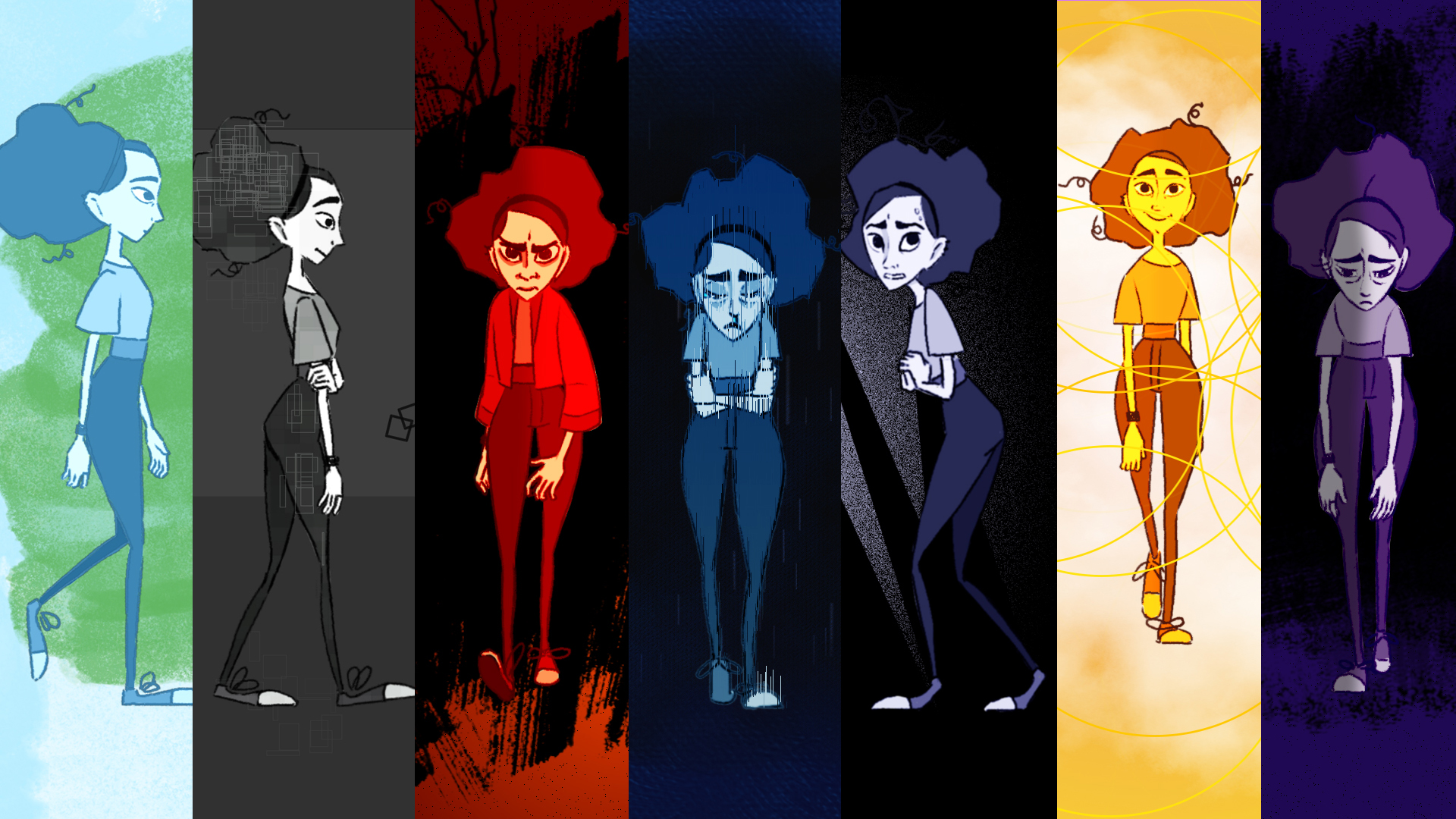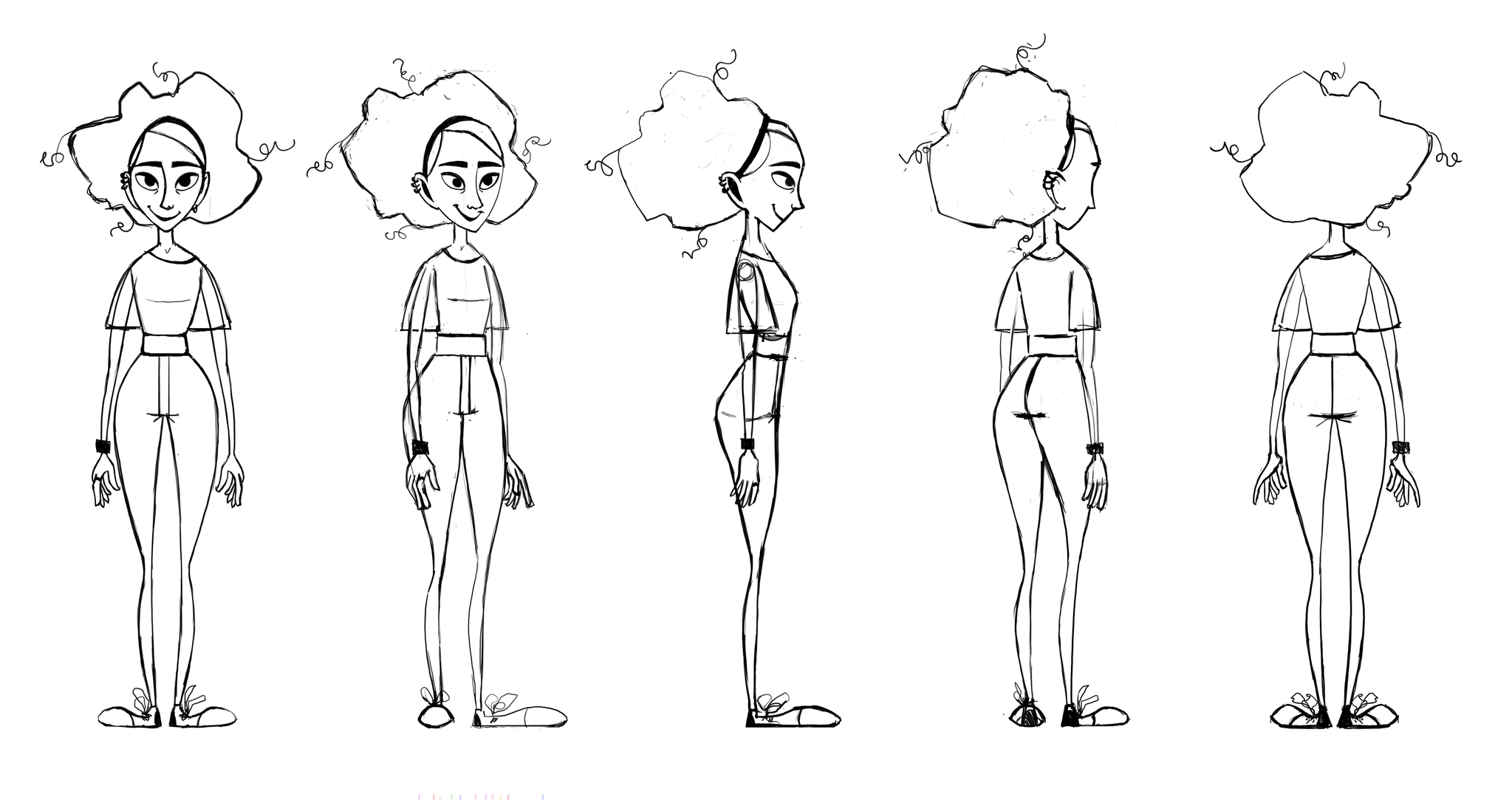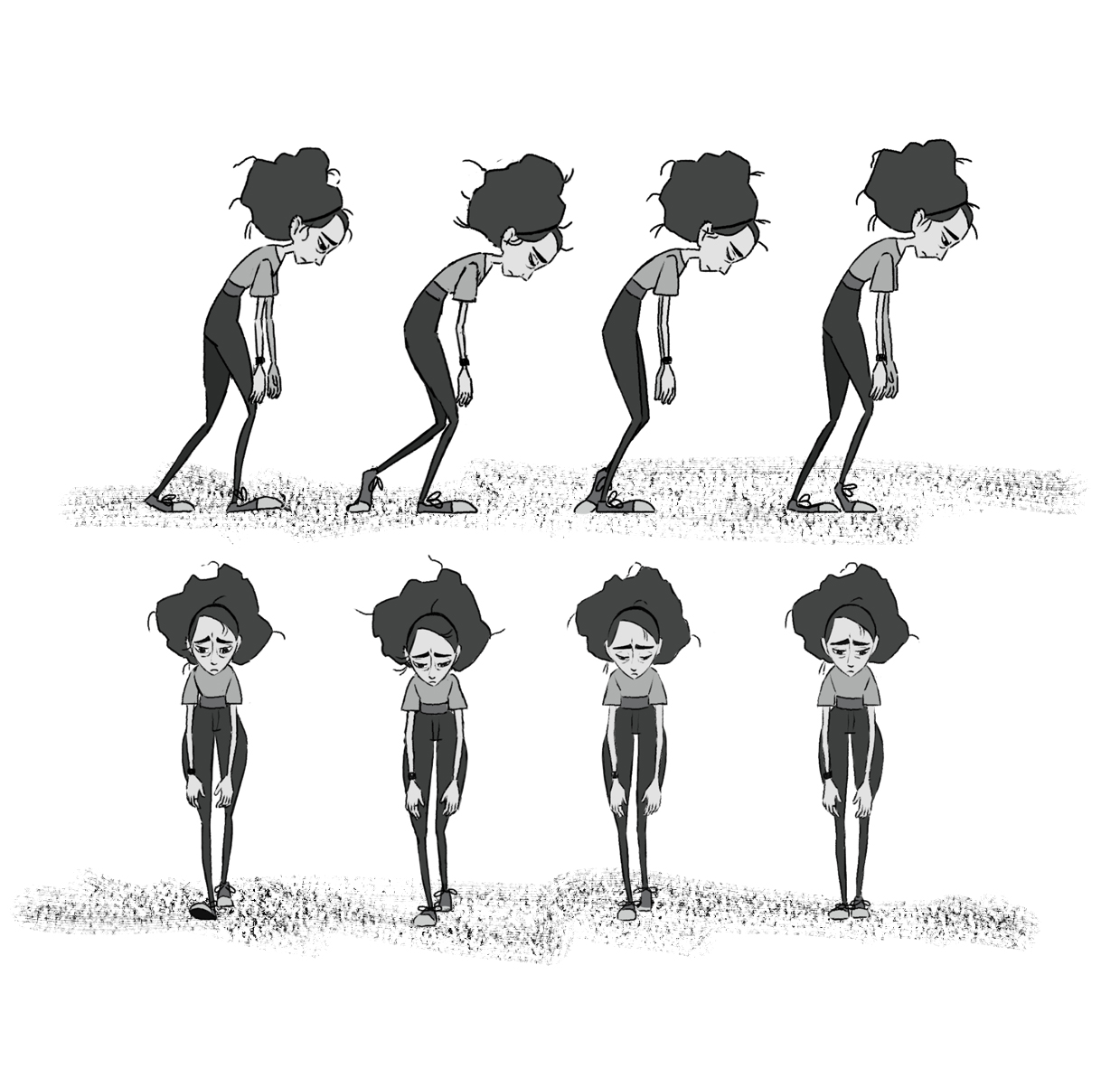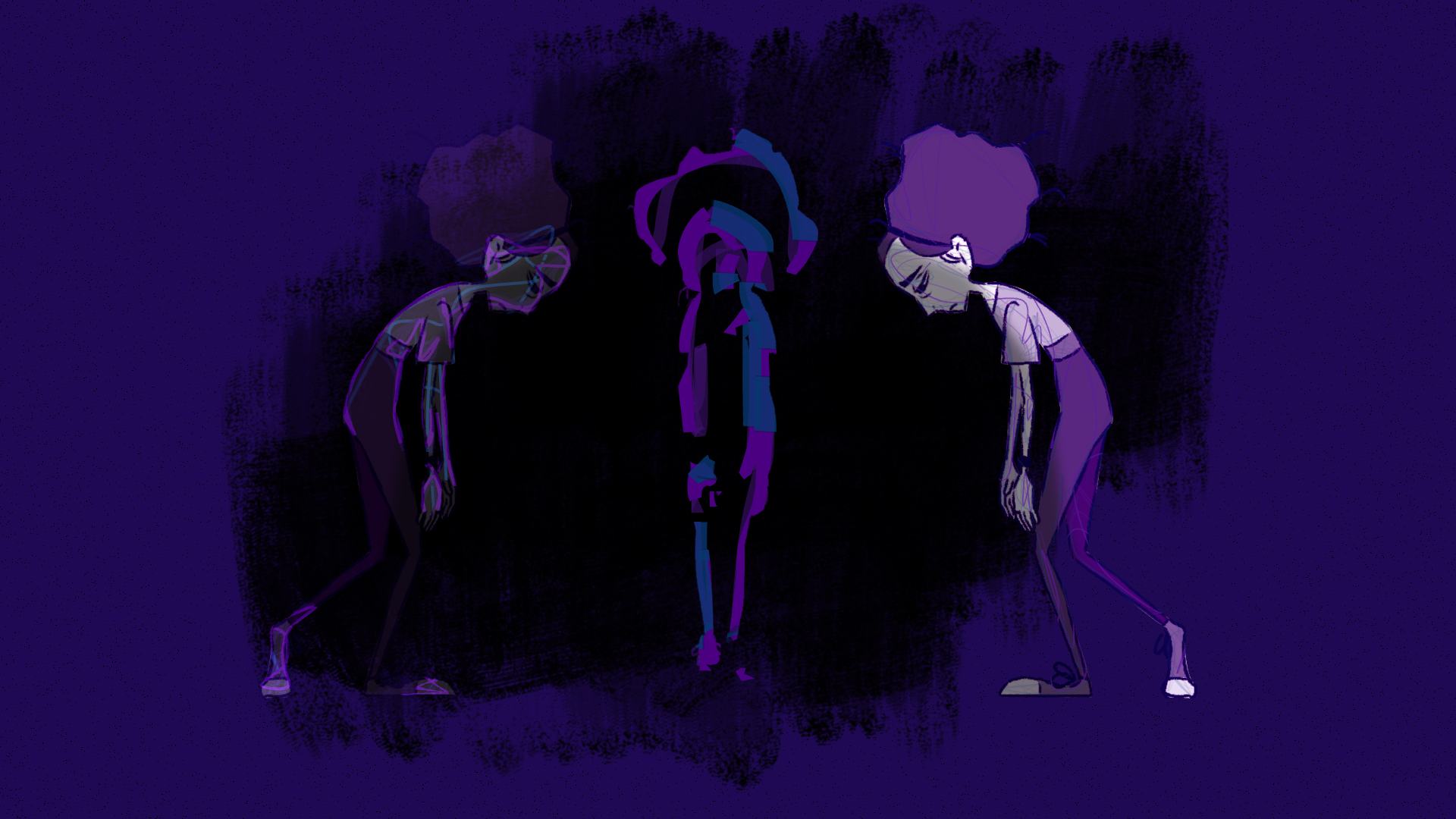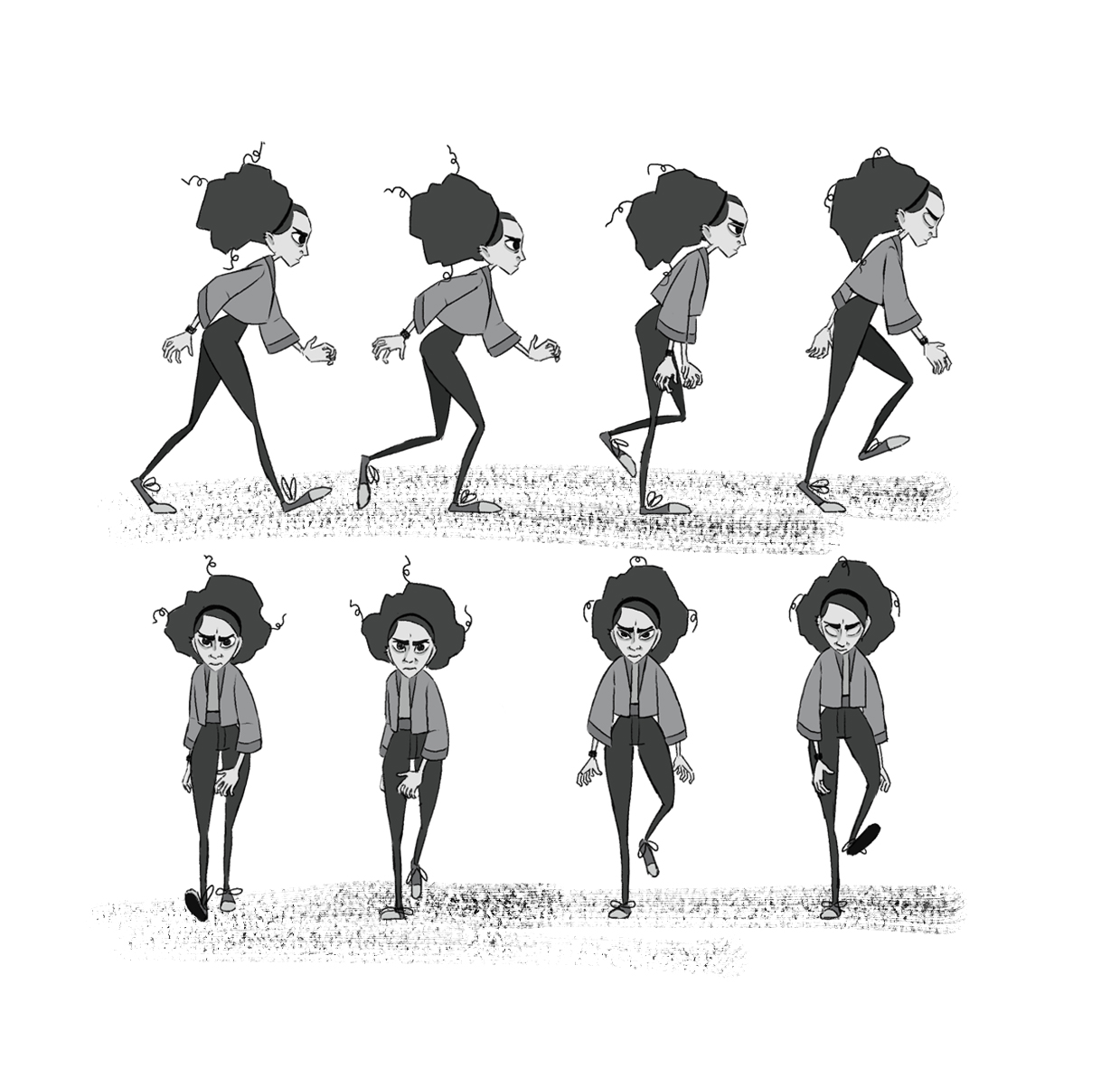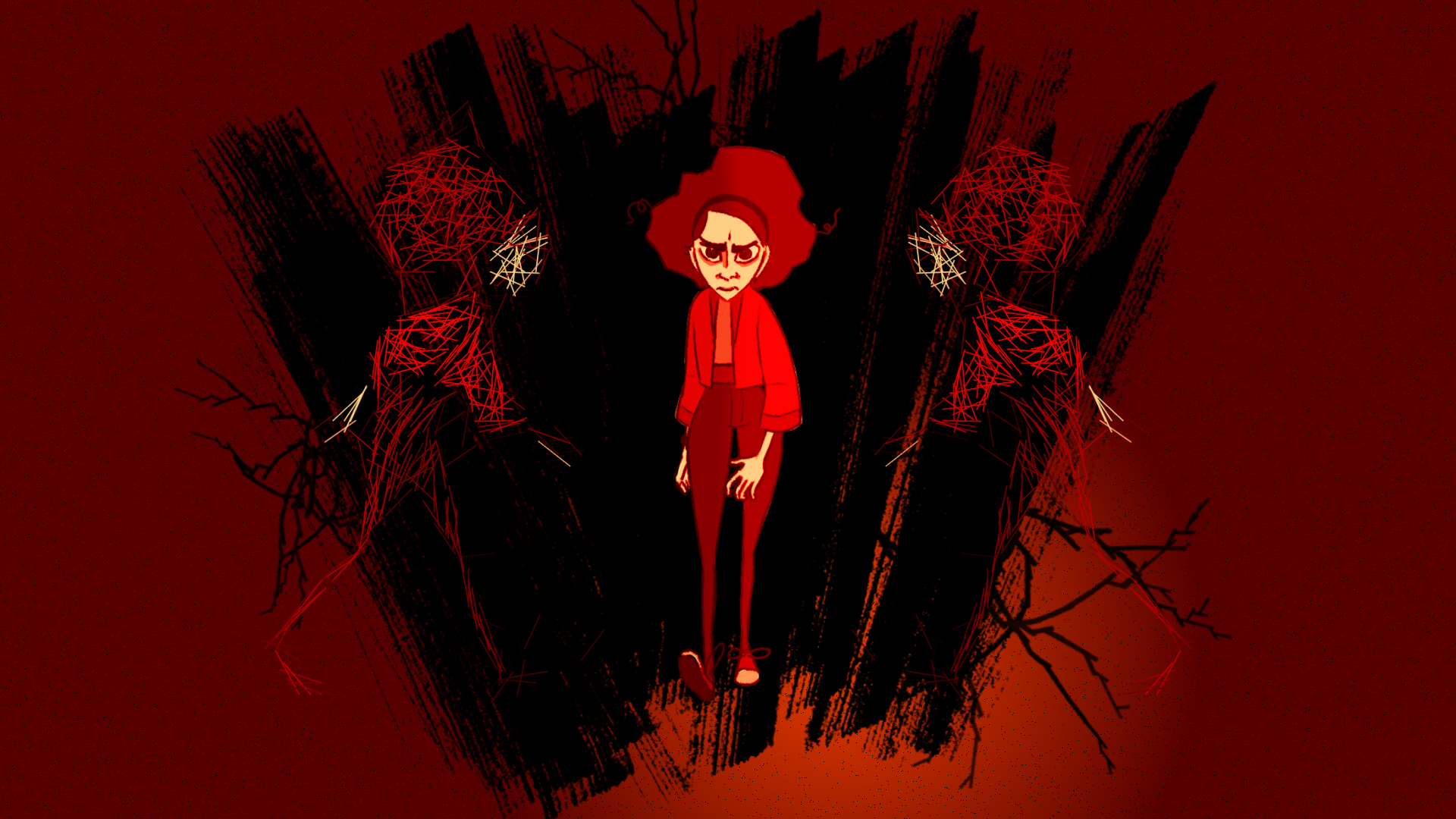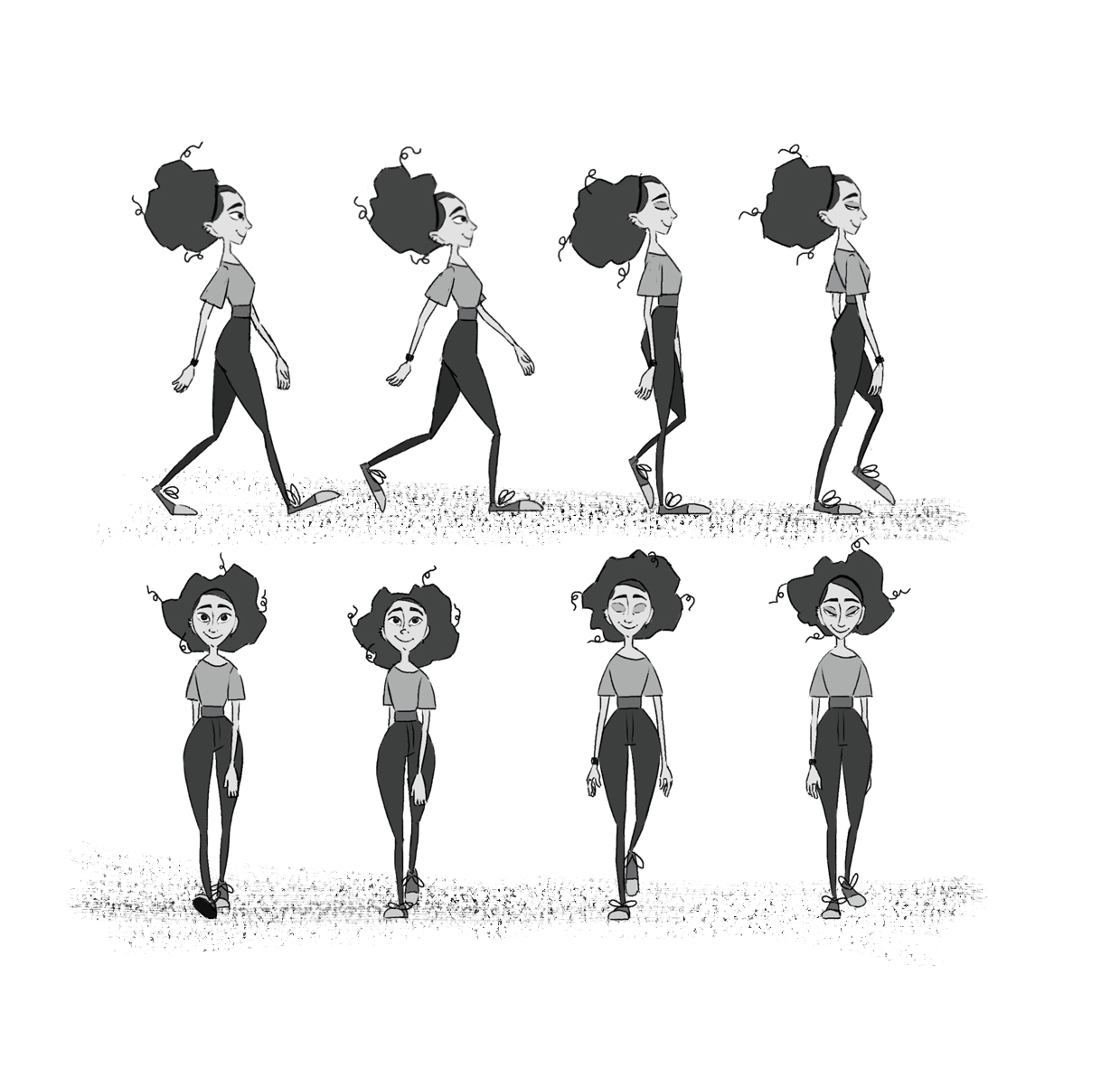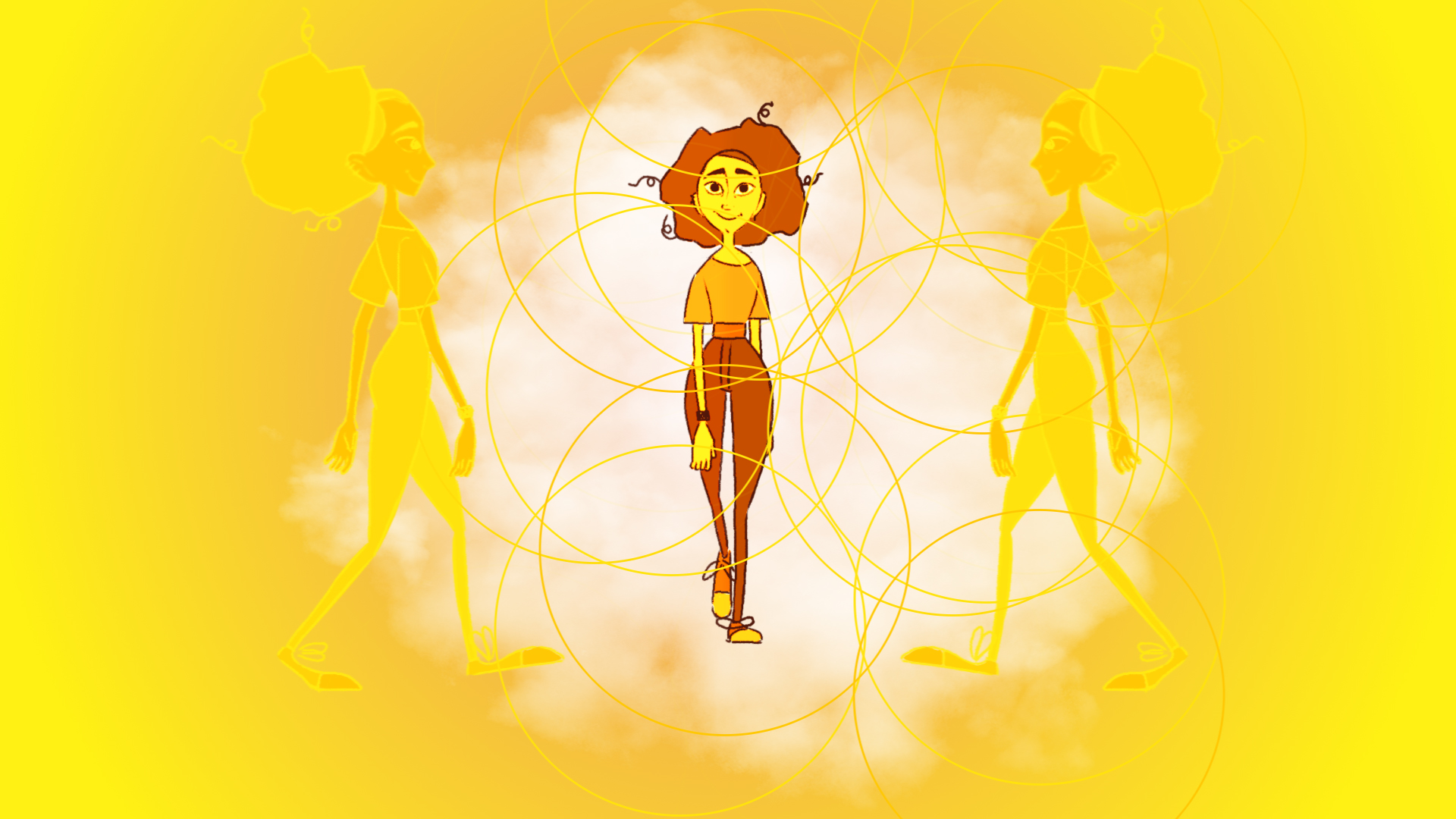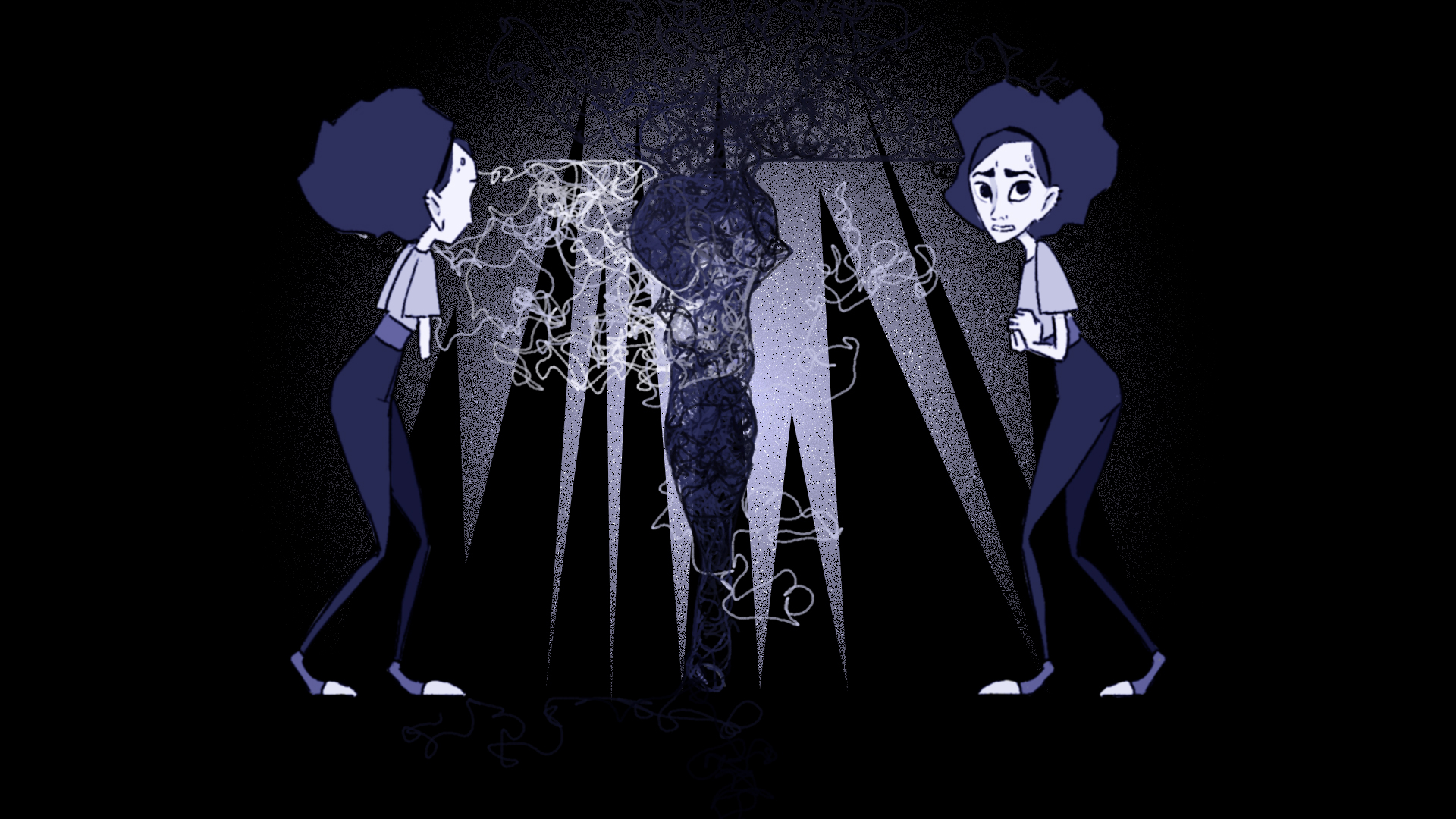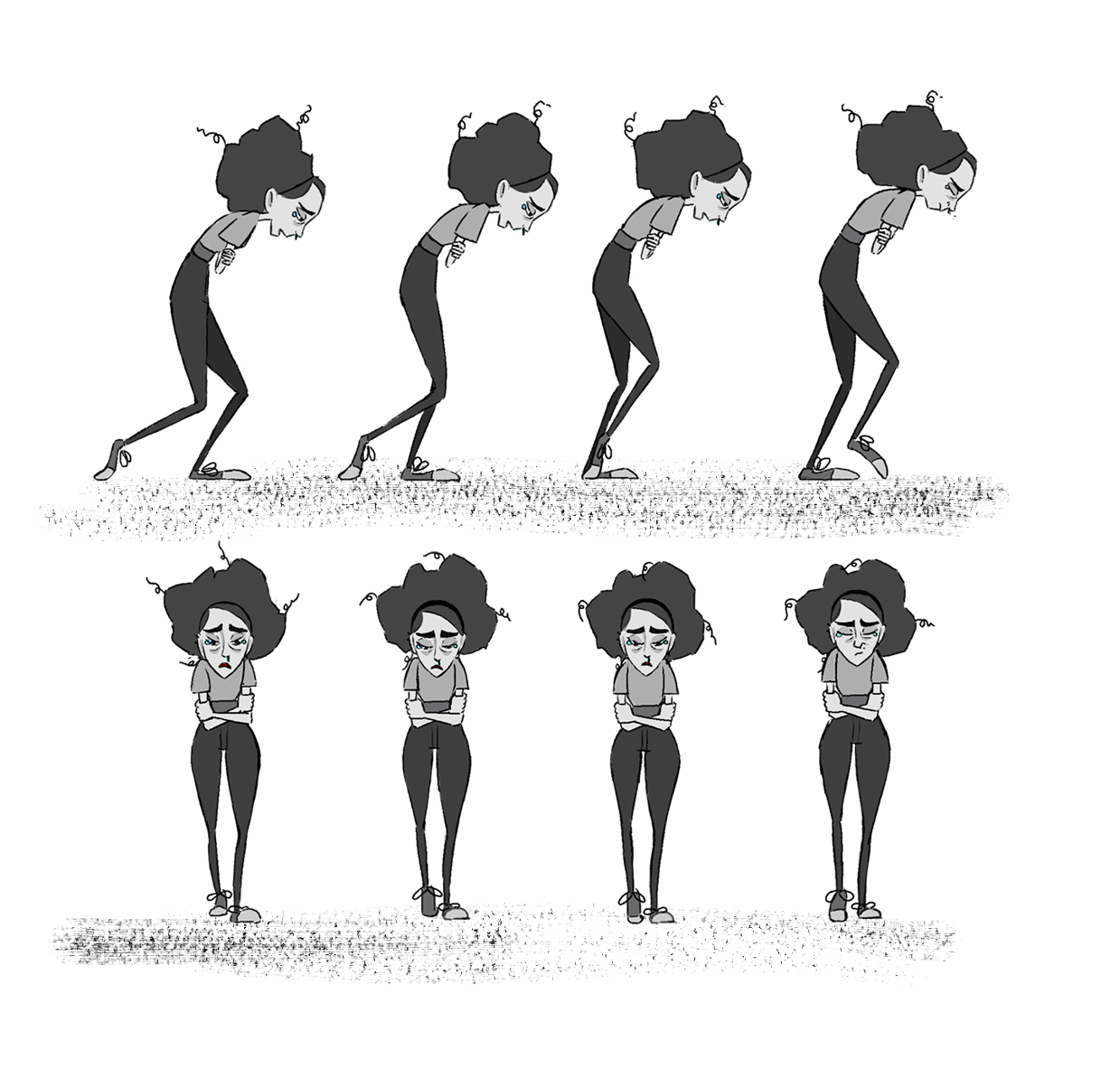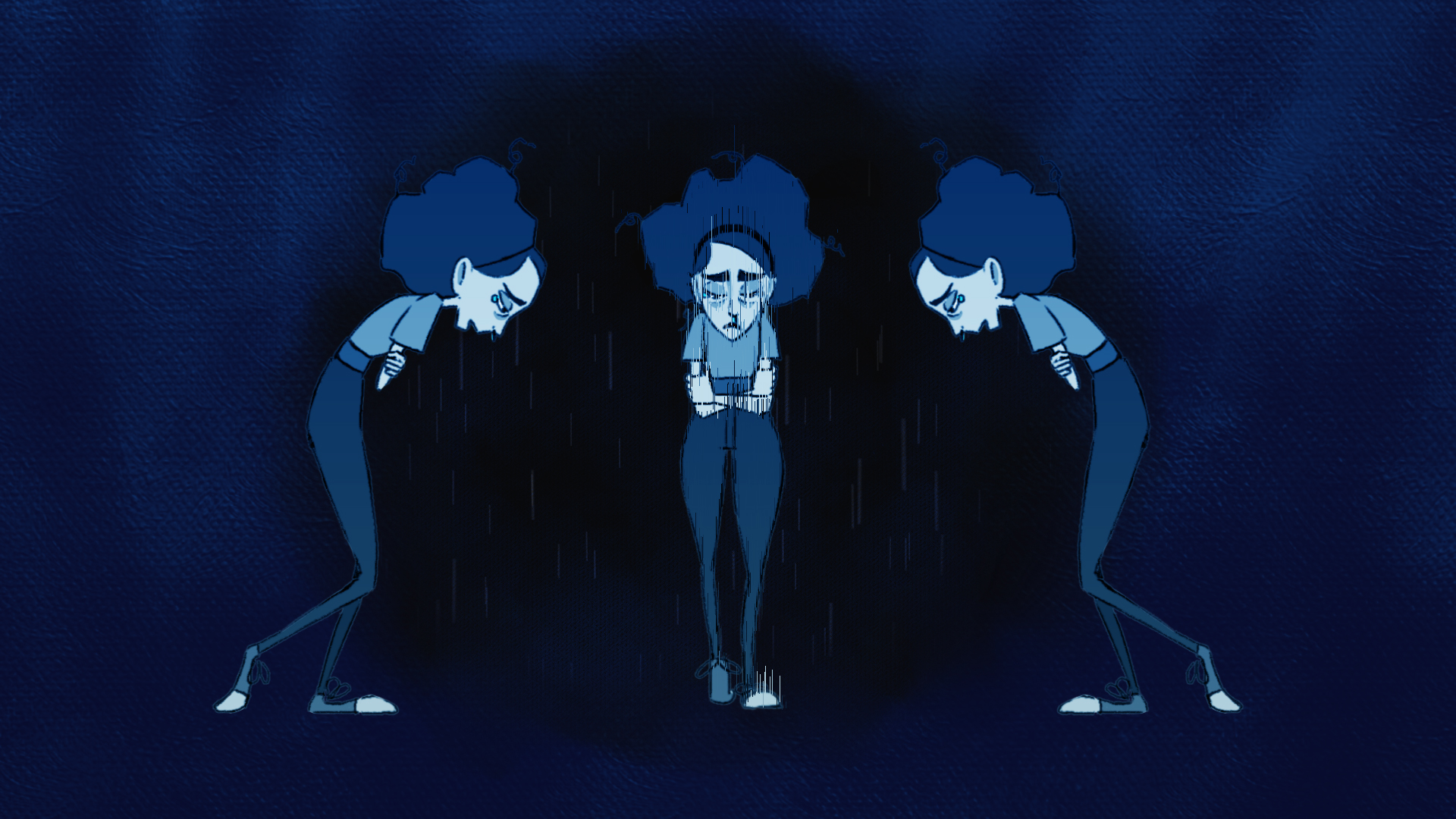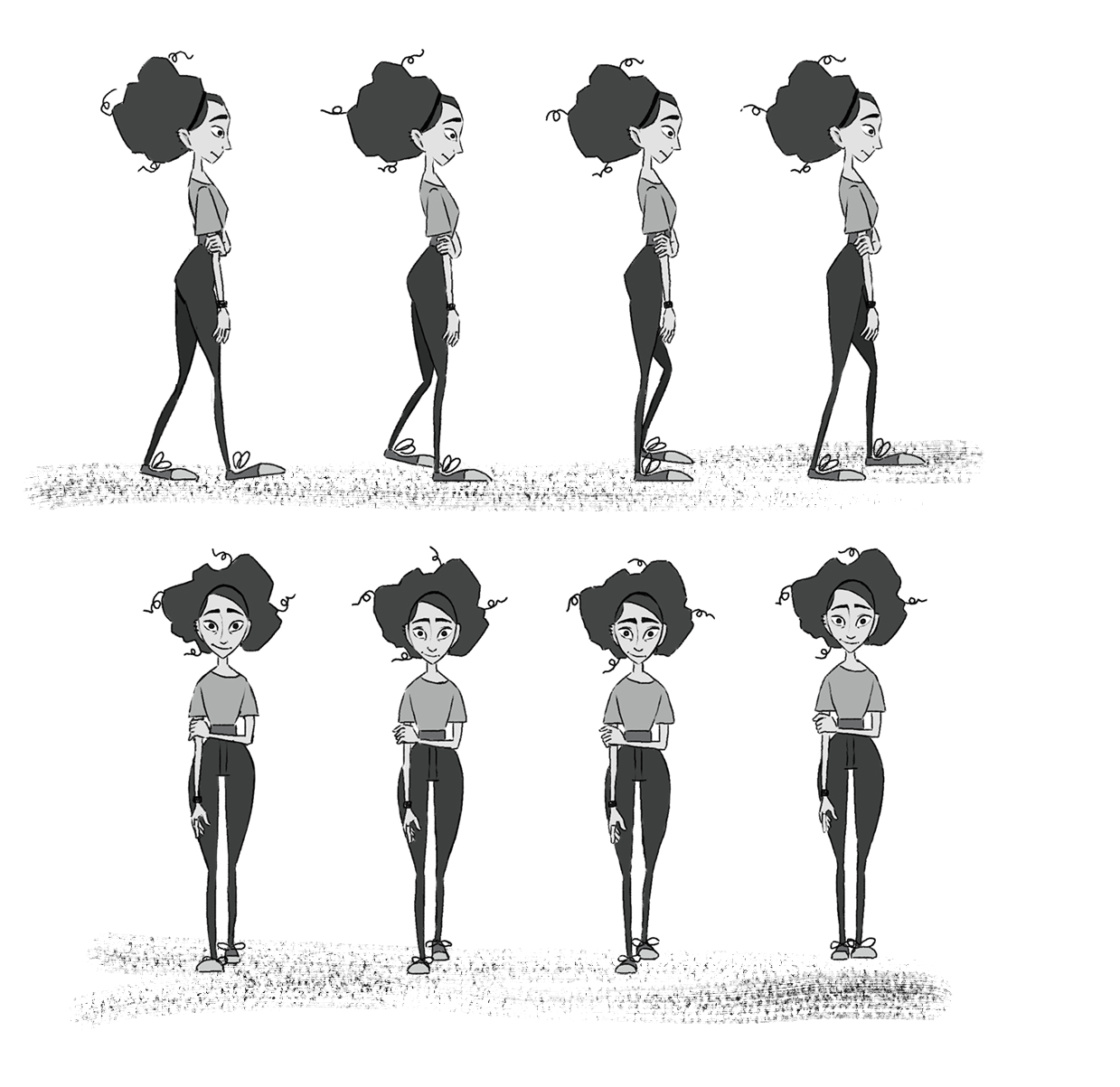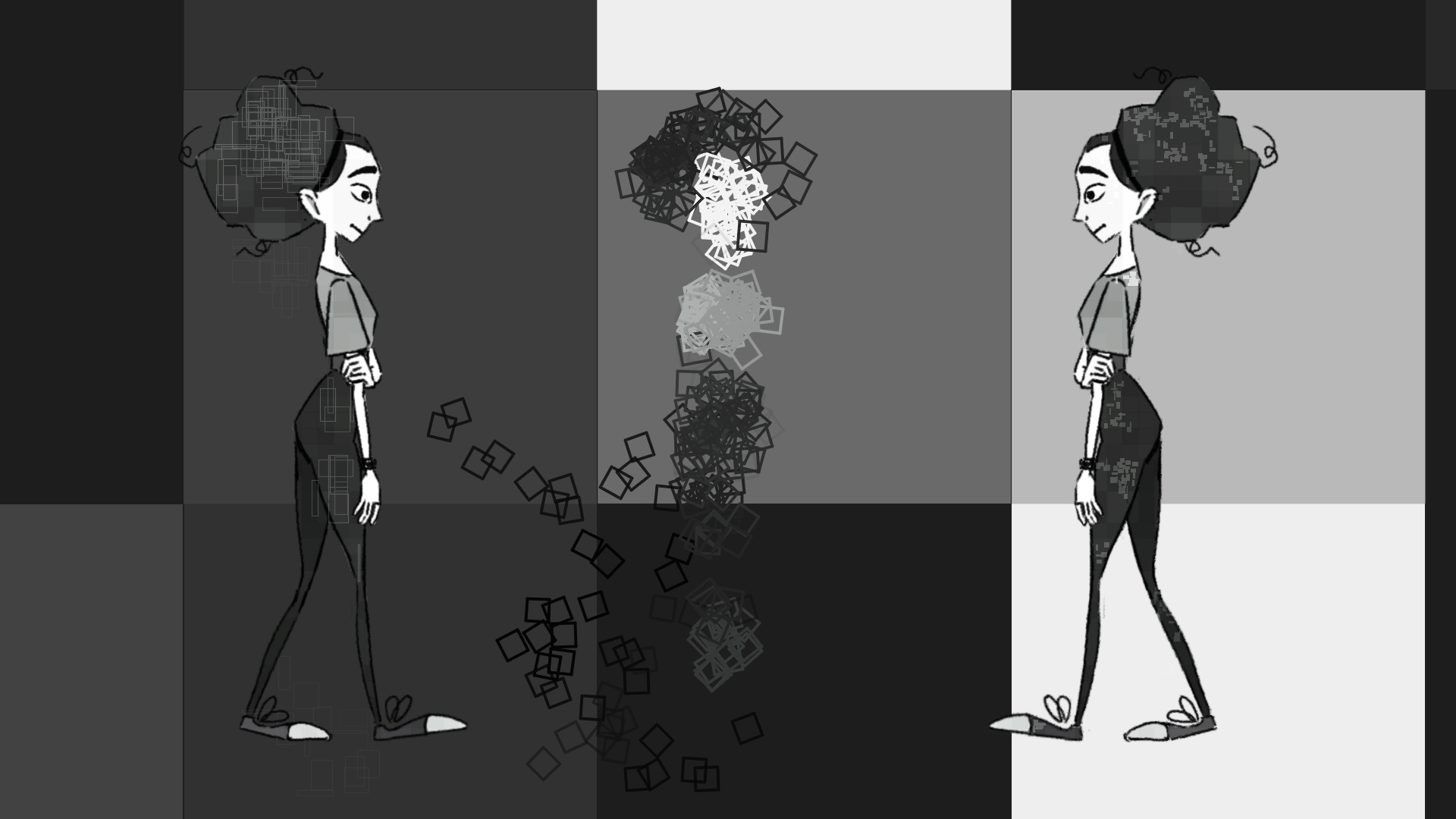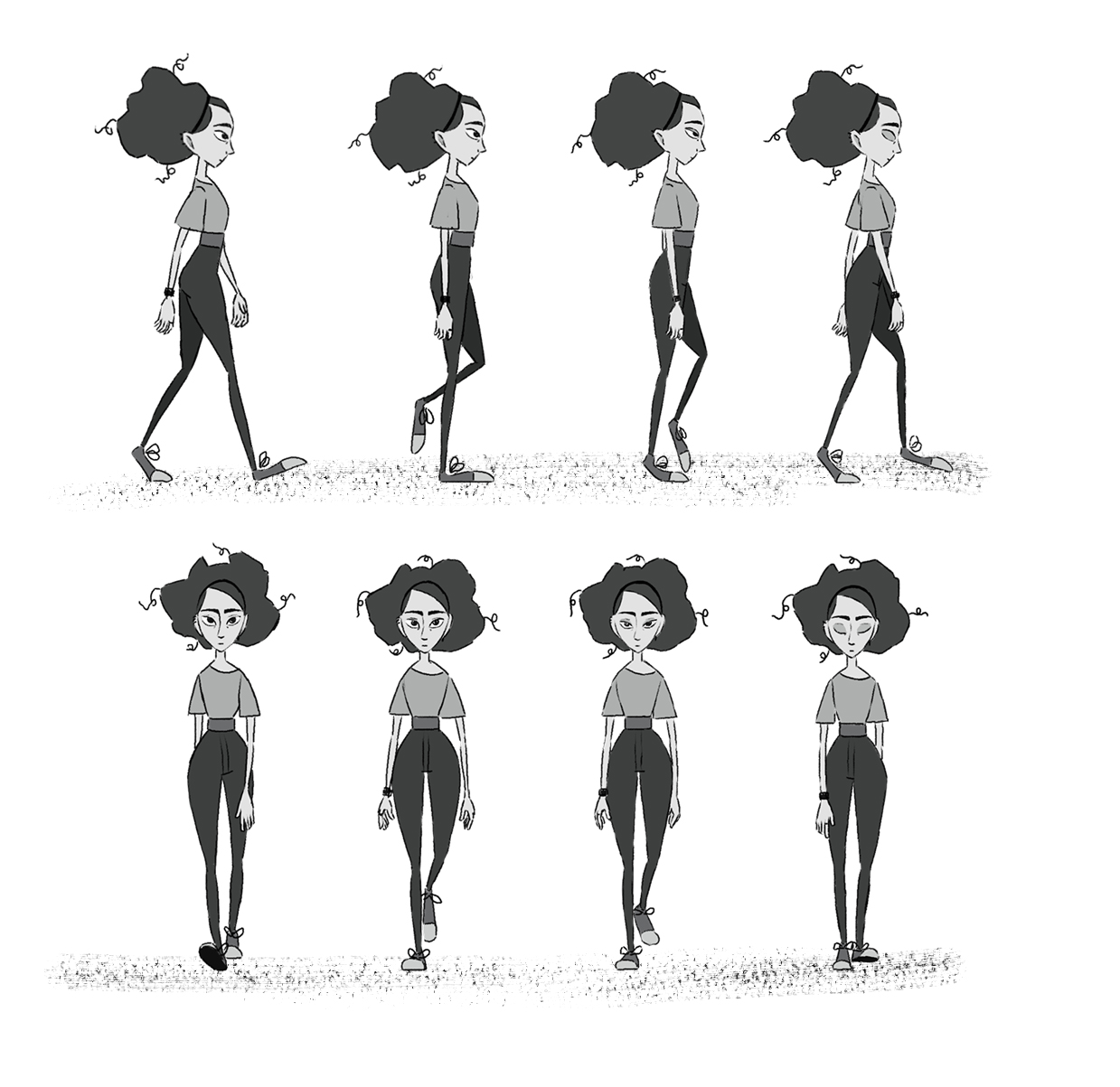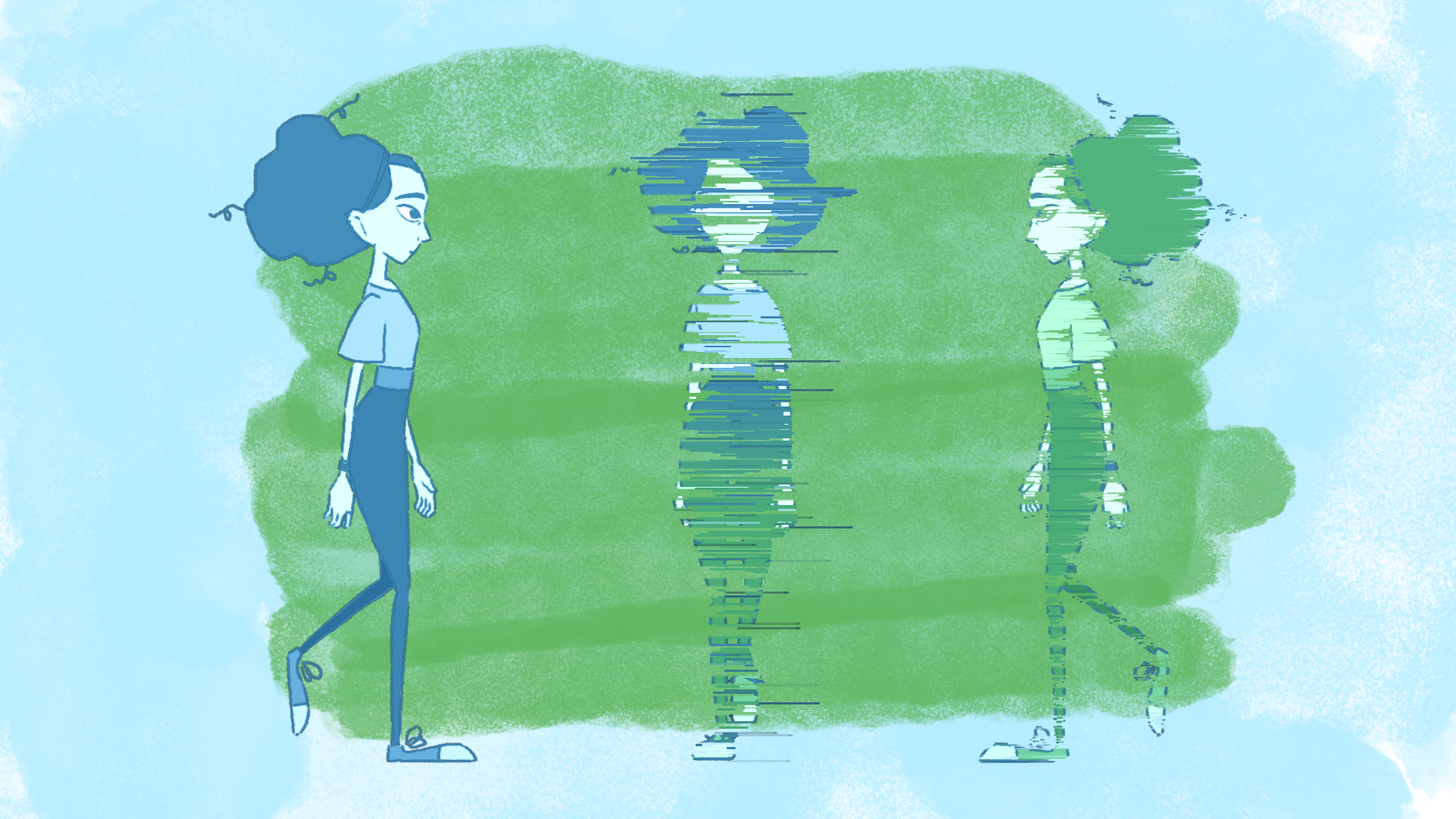This exploration delves into the potential of emotional storytelling through walk cycles. Moving beyond traditional animation, it utilizes the expressive power of modern tools to explore how line, shape, stroke weight, color, texture, and sound can be manipulated to create abstract narratives that evoke deeper emotional experience for the viewer.
Drawing on a foundation of psychological principles, scientific research, and relevant articles, the walk cycles become abstract narratives, provoking introspection and emotional connection. The subjective nature of this artistic language is acknowledged, with cultural backgrounds and personal experiences influencing interpretation. The exploration raises questions about the potential for a universal language of emotion in animation, one that speaks not just to the mind, but to the heart.
This ongoing journey of discovery aims to observe how viewers connect with these abstract representations and explore the potential for this approach to elevate the art of animation.
First, I am deeply thankful to Jennifer Berglund, a talented traditional animator who utilizes TVPaint to bring her creations to life, for her participation and invaluable assistance in creating the traditional animations featured in this project.
Second, I would like to express my sincere gratitude to Moa Schulman, whose guidance and support were invaluable throughout the writing process.
Have you ever noticed how a character's walk can speak volumes about their mood? From a confident stride to a slow shuffle, our gait reveals a surprising amount about our emotional state. Every walk tells a story. But translating emotions into a compelling narrative can be a challenge. It's not always a linear process.
I struggle to capture true emotion in the stories I meticulously craft. I spend ages illustrating and animating, but they often feel flat and lifeless. It's a paradox, isn't it? The more I try to force emotion, the less it seems to resonate. Maybe it's because authenticity is a tricky thing - it's subjective and ever-changing. What feels truly real to one person might fall flat for another. But here's the weird thing: Sometimes, unexpected, quirky ideas that pop into my head while I'm creating end up holding a deeper truth. These quirky moments - maybe a character sniffle suddenly, or bounce unexpectedly, or a seemingly insignificant detail pops up - can spark a connection with my feelings that my carefully planned scenes just can't capture.
Why is that? Because these unexpected moments tap into the source of genuine emotion. They bypass the planning and connect with the viewer on a deeper level. There's something powerful about the unexpected, and I want to explore that concept in some of my walk cycles.
This project explores how animation, specifically focusing on walk cycles, can be used to tell emotional stories. While meticulously studying the technical aspects of walk cycles and the science of emotion was informative, the results lacked soul. The animations likely felt conventional because emotions are nuanced and influenced by individual experiences. Pinpointing specific frame numbers and weight distribution might create physically accurate movement, but it misses the subtlety of genuine expression. And to get closer to this genuine expression, I need to explore deeper each aspect and element, extract the code that perhaps resonate with viewers on a deeper level than something that's been overly calculated. Choosing what to emphasize, stylize, and omit shapes the emotional impact of the art. When animation leans too heavily on technical precision (think rotoscoping), it risks becoming sterile, the emotional connection lost in a sea of intricate details. It's like teetering on the edge of the uncanny valley, where a near-perfect imitation becomes unsettling.
In this context, my aesthetic decisions become crucial. By embracing stylization, abstraction and moving away from pure realism, I invite viewers to connect emotionally with the animation.
To delve deeper into the concept of emotional storytelling through animation, I employed seven distinct walk cycles. Each cycle featured my protagonist, Mouna (see Fig. 1), and embodied a different emotion and narrative. While a simple stick figure could have communicated the core mechanics of walking, such an approach wouldn't have captured the subtle nuances of emotional expression. By including details like Mouna's facial expressions, I aimed to create a richer tapestry of emotions that allows viewers to connect with her on a deeper level.
While I started by diligently following established principles of frame-by-frame animation (think traditional hand-drawn techniques), this exploration wasn't just about technical mastery. The undeniable power of traditional animation held a certain allure, but the time-intensive process fueled my desire to push boundaries. This led me to explore the vast potential of modern tools like Adobe After Effects, algorithms, and other forms of new media.These digital tools unleashed a more experimental and improvisational approach.
My background in illustration and motion graphics seamlessly translated to the digital realm through After Effects. It felt like a natural extension of my traditional skills. It lets me combine the core principles of animation honed in programs like TVPaint and Harmony by Toon Boom, with these new tools to create something truly unique. Think of it as pushing the boundaries beyond a basic walk cycle by using algorithms and plugins to stylize movement, adding a unique layer of expression beyond the core walk cycle itself.
Imagine crafting an emotional landscape instead of a boring, repetitive cycle. Through visual storytelling, I created a film with animated visuals, colors, textures, strokes, and sounds for each walk cycle, capturing the essence of various emotions: depression, joy, sorrow, anger, denial, fear, and even neutrality. This animated experiment isn't confined to my own experience; it's designed to be welcoming and open to others, allowing them to connect with my and Mouna's emotions on a deeper level. The artistic details woven into each story are meant to resonate with your own experiences.
Storytelling isn't a one-way street, it's a shared journey. By entering my emotional space, you don't simply observe my feelings; you participate in them.
My exploration delves into the power of walk cycles to tell stories through emotions. While some might be familiar with the concept of a walk cycle, a series of frames or drawings creating the illusion of walking, I wanted to push beyond its basic function.
By unlocking the emotional language of walk cycles, this thesis explores their superpower for nonverbal communication. It's more than just technical mastery, it's about how these walks can bring stories to life and create a deeper connection with viewers.
- Psychological and Physical Manifestations of Depression in Gait
Ever feel like the world's lost its vibrancy? Like everything is painted in shades of grey? That's the grip of depression – a suffocating sense of purposelessness, a disconnect that severs you from the world around you. Activities that used to spark joy hold no power anymore. It's like your brain forgot how to feel good. It's a heavy cloak, this depression, one that weighs down not just the spirit but the body as well.
And that burden manifests in the way we move. A simple act like walking becomes a struggle. The body moves sluggishly, each step lacking the usual coordination. Every footfall feels like a chore, heavy and slow. Studies back this up – clinical psychology explores concepts like "psychomotor retardation" in depression, where movement slows, impacting a person's gait.
- Technical Animation Principles for Depression
In this animation, slowness became my muse. It's the key that unlocks the essence of depression, the main aspect of this character's heavy emotions.
I started with the familiar rhythm of a walk cycle, a foundation I knew well. But here, the animation changed. Each frame lingers a beat longer, stretching the movement in a slow-motion move. The protagonist herself seems to move under a heavy weight. Her center of gravity dips lower, a visual echo of a slumped posture. I achieved this by lowering her hips and exaggerating the downward tilt of the torso, a physical manifestation of the emotional burden she carries.
Posture suffers too, collapsing inwards. It's as if the weight of the world bends them forward, a visual language of hopelessness and despair. Shoulders slump, defeated, and the head hangs low, echoing the pervasive sense of emptiness.
This is Mouna. Her face, the window to her soul, reflects the emotional toll of depression. Her hair hangs unkempt, neglected. A line or two of worry etch themselves across her forehead, hinting at the weight she carries. Her eyes, once bright and lively, are now dull and lifeless, blinking minimally. Her gaze seems vacant, avoiding eye contact altogether. The corners of her mouth droop downwards, forming a downturned frown or a thin, pressed-together line. Puffy eyes, a tell-tale sign of fatigue or unshed tears, further emphasize the emotional strain.
The usual bouncy lift of the feet? Gone. Instead, I focused on a dragging motion. Imagine her feet reluctantly leaving the ground, her knees barely lifting before a heavy thud brings them back down. There's a lack of coordination too, one side a little weaker, a subtle limp that whispers of uneven effort, a slight hitch or unintended movement emerged that resonated with the character's depression. I chose embracing this unexpected “one side limp” because it added a deeper layer of authenticity.
Arms, once lively participants in movement, become ghosts. They hang limply at the sides, devoid of the usual swing that accompanies a purposeful walk. Even the limp adds another layer, a detail that hints at the struggle within. It's a visual language of sluggishness.
Here's a study of some key positions of Mouna’s walk cycle that convey depression, (see Fig. 2).Those illustrations, follow the walk cycle principals, adding the physicality of a depressed demeanor.
- Artistic Exploration: Line, Texture, Color, and Sound for Depression
Lines have always been my obsession. They dance across my screen, whispering stories or screaming emotions. Lately, I've been trying to capture the feeling of depression – that heavy weight that leeches your energy and motivation.
Slow lines became my first attempt. Deliberate, sluggish strokes that mirrored the lethargy clinging to me. Broken, disjointed strokes seemed to fit too – a visual representation of fragility, vulnerability, and uncertainty. Bending the lines can convey sensitivity and depth.
But depression is a strange beast. It can be heavy, a suffocating weight that presses down on your chest. Yet, there's a strange fragility to it as well, a feeling of being easily broken. This is where my biggest struggle lies. How to capture both the heaviness and fragility with a line? Thick lines? Thin? Broken? Each has its own voice, but none seemed to sing the full song of depression. What about mixing all? I will experiment with layering and overlapping lines thick, thin, and broken lines to create depth and complexity in the artwork outcome. This technique can symbolize the complex layers of emotions and experiences that contribute to the feeling of depression. There's a comfort, though, in knowing our brains understand lines. Scientists say we can recognize objects in simple drawings, even without color or detail. It's like a secret language, a way to speak directly to the subconscious.
Colors. I've been drawn to dark, muted tones – blacks, dark blues, indigo? A desaturated indigo! They echo the sadness and emptiness that depression brings. Black, a color of mourning in so many cultures. Indigo, heavy, and cold. Studies say these colors can even affect us physically, triggering feelings of gloom. Perhaps it's because they represent the absence of light, the very thing depression steals from you.
Texture is another tool I'm reaching for. Thickly applied paint, the kind that leaves ridges and bumps, feels right. It creates a physical sensation of weight, mirroring the emotional burden of depression. But texture isn't just visual anymore. Sound can be texture too.
I'm starting to experiment with soundscapes. Cold, echoing footsteps on hard resonant metal floors sound perfect. The hardness of the metal will produce a distinct sound that can convey a sense of coldness and emptiness. The sound of each footfall should reverberate in the silence, amplifying the sense of isolation and loneliness. And then I am experimenting with occasional creaks or squeaks sound of broken glass. It's a visceral reminder of fragility, the feeling of being shattered by depression.
This exploration, this battle with lines, colors, and sound feels crucial. I know there's no single answer, no universal image of depression. But if I can capture a sliver of its truth, a flicker of recognition in someone's eyes, then maybe, just maybe, my animated art will serve a purpose after all.(See Fig. 3)
- Psychological and Physical Manifestations of Anger in Gait
Anger. It's a firecracker exploding within, and the aftershock ripples through the body, transforming even the simplest walk. Capturing this physical manifestation of frustration became my latest obsession.
Imagine someone on a purposeful mission, their steps shortening and deliberate. Each footfall strikes the ground with a determined thud, a forceful punctuation mark echoing their emotional state. Their body leans forward ever so slightly, a physical embodiment of the internal drive pushing them onward. This isn't a leisurely stroll – it's a purposeful march, a visual representation of the need to confront or act.
Psychologists like Paul Ekman have documented the fascinating connection between anger and muscle tension. This tension wasn't just about clenched fists or arms held rigidly – I wanted it to permeate the entire body.
- Technical Animation Principles for Anger
How do I capture that fiery essence in a walk cycle?
First, I cranked up the animation speed. But these weren't dainty steps – each one packed a punch, a forceful declaration of her emotional state.
The character's center of gravity became my next tool. Neutral stances wouldn't do. A slight shift forward was needed, like a coiled spring ready to unleash. This subtle change translated into the forward lean and tensed posture that screams anger.
Mouna’s facial expressions became my next challenge. Here, narrowed eyes – like laser beams – focus her gaze with a piercing intensity, further emphasizing the burning anger within. A furrowed brow completes the picture, a deep crease etched across the forehead like a battle line.
But I wanted to push it further. Weight distribution became a playground for exaggeration. More emphasis landed on the front foot as it slammed into the ground with a sharp heel strike. Don't forget the push-off, though! A slight bounce here showcased the propulsive energy behind each step, a visual representation of the internal drive pushing her onward.
Fists were tempting. The go-to symbol, a surefire way to scream anger. But then something interesting happened. Clenched fists felt too...obvious. This anger, it simmered beneath the surface. For the arms, I needed an extension of that intensity. Sharp angles became my new lines flow, replacing the gentle curves of a normal walk. But here's the twist: hands and fingers, tensed and frozen, like claws poised to strike.This tension created unexpected dynamic and potentially unsettling portrayal.
For me, the true power of anger lies in this thrilling dance between pushing artistic boundaries and raw expression. Every element seems to crackle with the raw energy and tension that defines this fiery emotion.
Here's a study of some key positions of Mouna’s walk cycle that convey anger emotion, (see Fig. 4).Those illustrations, follow the walk cycle principals, adding the physicality of an angry demeanor.
- Artistic Exploration: Line, Texture, Color, and Sound for Anger
Anger. It's a firestorm within, a force that demands both visual and emotional impact. To capture this intensity, I knew my anger walk cycle needed to be a multi-sensory experience. First, the color palette needed to be a fiery explosion, a reflection of the raw energy coursing through the character. Red – the undisputed champion of anger – had to take center stage. But how to use it? Red can be overwhelming, so finding the right balance with accents of orange (for a touch of heat) or black (for added depth and seriousness) became crucial.
Lines became my next weapon. Sharp and angular, they needed to capture the raw energy like jagged lightning bolts. Concurrent direction? This will convey energy! Bold and forceful strokes would further emphasize the character's strength and determination. This wasn't a scene for gentle curves. Splatters of paint or ink or fire and flames? Mimicking the chaotic and burning nature of anger, felt necessary. These random strokes would echo the character's loss of control, the simmering rage threatening to boil over. Zigzag lines couldn't be ignored either. Their chaotic energy perfectly reflects the unease and intensity of the moment.
Incorporating broken, cracked paint textures, such as fragmented or shattered surfaces, can symbolize the disruption and chaos that anger brings.
The soundscape had to become another layer of anger. Sounds reflecting the physiological response like rapid breathing or a pounding heartbeat. Now, imagine the character walking on solid, unyielding materials like brick or concrete. These sounds – heavy thuds against the ground – would symbolize the hardened and unrelenting nature of her anger. Their sturdy structure could evoke feelings of stubbornness and resistance. Fire, with its crackling and roaring, could be another option. Fire can symbolize passion and intensity, but it can also represent the destructive power of anger.
By combining these elements, I hoped to create an anger walk cycle that transcended mere movement. It had to become a multi-sensory experience, a visual and auditory assault that captures the raw intensity of anger – a forceful stride that warns, intimidates, and reflects the brewing storm within. (See Fig. 5)
- Psychological and Physical Manifestations of Joy in Gait
Ever feel like the world's bursting with color? Like every step you take is on a springboard, propelling you forward with a smile? That's the magic of joy – an infectious energy that dances through your body, transforming even the simplest walk into a skip. Capturing this infectious energy in animation became my great curiosity.
Happiness, I realized, isn't just a facial expression. It's a full-body experience, reflected in the way we move. Imagine someone brimming with delight, their steps taking on a light and energetic quality. Each footfall seems effortless, a smooth transition propelled by an internal spring. Their body, too, becomes an extension of this joy – upright and confident, with shoulders back and head held high. Every movement flows with a relaxed fluidity, mirroring the ease of their happy state.
Research by psychologists like Sonja Lyubomirsky reinforces this connection between happiness and physical behavior. They've documented how happiness activates the brain's reward center, leading to increased energy. In animation, this translates into a bouncier gait, a visual representation of the character's inner spark.
- Technical Animation Principles for Joy
Now that I've cracked the code on the psychology behind a joyful walk, let's bring that understanding to life in animation! This is where the technical playground opens up!
The key to capturing joy in animation is infusing the walk cycle with a sense of lightness and energy. Speed is the first tool. Imagine Mouna bursting with happiness, her steps becoming brisker than a normal walk. But there should still be a sense of effortlessness to her movement, like she’s barely touching the ground.
The character's posture also plays a crucial role. Forget slumped shoulders and downcast eyes. For a joyful walk, I want a confident stance, shoulders back and head held high. This posture exudes confidence and reflects Mouna’s positive outlook on the world.
Movement becomes my next tool. Unlike the stiff, rigid movements of anger, joy is all about fluidity and ease. Imagine a relaxed swing of the arms, mirroring the lightness of the steps. And don't forget a subtle bounce in the walk cycle, a visual representation of that internal spring propelling them forward. It's like she has a secret trampoline under each foot!
But why keep things simple? You might be wondering if a joyful walk cycle needs quirky moments to truly connect with the audience. An unexpected bounce, that can add personality and a touch of surprise. Bouncy equal happy, right? However, I've found that for this loud walk of joy, subtlety can be even more powerful. Our brains are wired to pick up on even the most delicate shifts in body language. By focusing on the core principles – a touch faster speed, confident posture, relaxed, fluid movements, and a subtle bounce – I create a believable portrayal of joy that resonates with viewers. It's a clear message, free from distractions, allowing them to connect with the character's happiness on a more fundamental level.
There's also a beauty in leaving some room for interpretation. The absence of quirky moments allows viewers to fill in the blanks with their own experiences of joy. This personalizes the connection and can be even more powerful than a specific action.
It's a symphony of animation, each element playing its part to bring that joyful spirit to life!
Here's a study of some key positions of Mouna’s walk cycle that convey joy emotion, (see Fig. 6).Those illustrations, follow the walk cycle principals, adding the physicality of a happy demeanor.
- Artistic Exploration: Line, Texture, Color, and Sound for Joy
Joy is a melody, and I want my animation to sing! But how do I translate that infectious energy into visual and auditory elements? This is where the artistic exploration begins.
Curved and wavy strokes are the key here, with a light and varied line weight, mirroring the dynamic and lively nature of joy. Think of the lines as brushstrokes – thin and wispy in some areas, and slightly thicker and more defined in others to capture that sense of spontaneity, reflecting that carefree attitude often associated with happiness.
Research even backs this up – apparently, our brains are wired to find curved lines more appealing! And tend to require less cognitive effort to process compared to angular shapes. This ease of perception might contribute to their inherent appeal. Straight lines might say "serious" or "powerful," but curves whisper "gentle" and "playful." It's a fascinating dance between form and emotion!
Circle! A universal symbol of unity, completeness, and harmony. Its smooth, curved lines convey a sense of wholeness and balance, evoking feelings of contentment and happiness.
Yellow, oh yellow! You're sunshine personified. This cheerful hue instantly pops into my mind when I think of joy. It's bright, energetic, and evokes the warmth and radiance of pure happiness. It's like bathing the animation in a golden light, spreading positivity with every frame. To balance it, orange comes in hand. Orange is created by mixing red and yellow, combining the energy of red with the optimism of yellow. This balanced combination can evoke a sense of harmony and well-being, contributing to feelings of happiness and joy. Specifically amber, because of its association with greater confidence and better self-esteem. A dash of white might bring out the contrast between yellows and oranges, and white offers an inner cleansing and purifying of thoughts, emotions and, ultimately spirit, which convey a sense of ease and joy.
Here's where things get interesting. While smooth textures can evoke calmness, I want to avoid them completely for joy. Joy is about movement, energy, and a sense of delightful vibrancy. So, I'm thinking more along the lines of… soft, fluffy textures! Imagine the feeling of walking on a cloud – that's the kind of texture I want to capture. It whispers comfort and invites the viewer to imagine the sheer bliss of sinking their toes into something delightfully soft. Think soft grass, a fluffy sheep, or even the comforting texture of a favorite stuffed animal. These textures become a visual representation of the ease and contentment associated with joy.
And let's not forget sound! For joy, I imagine the light, crisp sounds of her feet skipping on soft grass. Maybe a playful bird chirping in the background. These sounds add another layer of immersion and can help transporting the viewer right into the heart of the joyful moment.
It's a sensory feast that captured the essence of this delightful emotion, leaving me with a smile and a lighter heart. (See Fig. 7)
- Psychological and Physical Manifestations of Fear in Gait
Ugh, fear is a creepy little critter to animate. Fear is all about tension, a knot in your stomach that translates into a shaky walk cycle.
Fear shrinks you down, turning your walk into a series of tiny, tentative steps. It's like tiptoeing through a minefield, every step a delicate probe for hidden dangers. Small steps, that's the key. Forget confident strides; fear turns you into a scaredy-cat, tiptoeing through a haunted house. Fear hunches your shoulders forward, collapsing your entire upper body inwards. Imagine a scared turtle withdrawing into its shell – that's the kind of defensive posture fear creates.
- Technical Animation Principles for Fear
Alright, I'm diving into this walk cycle, but Mouna isn't waltzing through the park. Fear is her driving force. Let's hunch those shoulders a bit, inwards like she’s trying to make herself smaller, the upper body slightly bent as if to protect vital organs.
This walk feels stiff. Fear is tense, right? Shortening the strides, making them hesitant by bending the knees inward. Now that frantic energy is building nicely.
But fear isn't just about big movements. Subtlety can be creepy too. How about adding these little glances over her shoulders? Quick, jerky motions, constantly checking her back. One over the left shoulder, then a snap to the right. Yeah, that adds a nice layer of paranoia.
Now for Mouna’s face. Wide eyes, dilated pupils for sure. Eyebrows furrowed, like she’s concentrating super hard, trying to see everything at once. A bead of sweat trickling down her forehead wouldn't hurt either. A slightly open mouth with a thin, stretched line and wide nostrils portrays the character struggling to breathe, overwhelmed by the situation.
Ah, the hands! Here's where I can inject some personality. Fear manifests in these tiny, nervous gestures. A repetitive hand rub, back and forth, depicting panic. This unconscious outlet for her distress adds believability. The intensity of the rubbing becomes almost comical, adding an unexpected layer that can heighten the fear.
This is feeling good! This walk cycle screams fear.
Here's a study of some key positions of Mouna’s walk cycle that convey fear, (see Fig. 7).Those illustrations, follow the walk cycle principals, adding the physicality of an afraid demeanor.
- Artistic Exploration: Line, Texture, Color, and Sound for Fear
Fear is a chilling symphony, an orchestra of visual and auditory cues that play on our deepest anxieties. As an artist, I want to capture this essence, to translate that creepy feeling into a tangible experience. Here's how I'm thinking of composing this symphony of fear:
Fear needs thick, wiggly lines, like menacing curvy shadows crawling across the screen. I can add a dash of chaos with varied line weight. Thin, nervous lines can snake around the thicker ones, amplifying the emotional impact, like a heart racing with terror. Sharp, jagged lines become the jagged teeth of fear, biting into the composition, and evoking a sense of unease and for a touch of unpredictability, I might throw in some erratic lines, mirroring the racing thoughts and anxiety that come with fear.
Shapes become my tools for building tension. Sharp, pointed edges like triangles and jagged shapes are like danger signs, screaming "threat!" at the viewer.
Rough and abrasive textures to evoke a feeling of unease and discomfort. This could include textures like sandpaper.
The color palette needs to be a chilling whisper. Dark like the inky blackness of a moonless night. Deep shades and cool, chilling tone of dark blues. Limited source of light is key. But fear isn't all gloom. Accents of red and orange can burst onto the scene, like a sudden flare in the darkness, adding a jolt of urgency and danger.
Sound is the final touch, the element that truly brings the fear to life. A pounding heartbeat becomes the soundtrack to terror, mirroring the panicked state of the character. Whispers and sudden noises, trying to keep the viewer constantly on guard, creating sense of paranoia.
And to truly paint a picture of vulnerability, I can add sounds like footsteps crunching on gravel, the unsettling scrape of something sharp.
This is the symphony of fear I'm composing – a chilling combination of lines, shapes, colors, and sounds that might send shivers down the spine and leave the viewer breathless with terror. (See Fig. 8)
- Psychological and Physical Manifestations of Sadness in Gait
Sadness weighs you down, a leaden blanket that steals your energy. Capturing this emotional state in animation means translating that heaviness into a slow, shuffling walk cycle. Imagine someone lost in thought, trudging through a storm cloud of sadness, dragging their feet across the ground. No confident strides here, just a listless meander, each step a chore.
- Technical Animation Principles for Sadness
Let's see how I can translate that weight into animation. First things first, posture. Shoulders slump inwards, like a wilting flower. Imagine her trying to shrink into herself, the whole upper body hunched over as if seeking comfort in a self-made cocoon.
Reduced speed and short steps are key here – tiny, deliberate movements that scream "low energy." This walk feels like wading through molasses. Bent knees complete the picture of dejection, mirroring the way sadness seems to bend your spirit.
Slow, shuffling movements, head hung low, like her gaze is glued to her shoes, unable to face the world.
That's the body language, but the face is where the real story unfolds. A lengthened face, like it's being stretched by gravity, reflects the weight of the world on her shoulders. Inner brow raises and downturned lips – a picture painted in shades of despair. Maybe a slightly open mouth, a silent sigh escaping, hinting at the unspoken words of sorrow. Droopy eyelids, like half-closed curtains, create a sense of withdrawal from the world. Slow blinks add to the melancholic mood, these eyes are welling up, threatening to spill over with tears. An unexpected occasional sniffle, a testament to the raw emotion she’s trying to contain, can add a layer of authenticity. Another detail that popped unplanned, is arms instinctively wrapping around herself, like seeking a hug from herself in the face of emotional chills.
This is starting to come together. It's a slow, deliberate dance with sadness, reflecting Mouna’s heavy heart and that's the story I want to tell.
Here's a study of some key positions of Mouna’s walk cycle that convey sadness, (see Fig. 9).Those illustrations, follow the walk cycle principals, adding the physicality of a sad demeanor.
- Artistic Exploration: Line, Texture, Color, and Sound for Sadness
Sadness – it's a melody in shades of blue, a symphony played on drooping lines and soft textures. Here's how I'm thinking of translating that emotional weight into a visual and auditory experience.
Thin lines feel right for sadness. They evoke a sense of subtlety and fragility, mirroring the delicate nature of the emotion. Maybe even some broken or dotted lines – a visual representation of incompleteness, reflecting the feeling of something missing. And vertical lines can't be ignored. They have a way of drooping downwards, just like a head bowed in sadness. Adding watercolor textures to the lines, will evoke a soft and delicate appearance, with layers of translucent washes blending seamlessly together. This softness can mirror the fragile and delicate nature of sadness.
The color palette needs to be a melancholic whisper. Are you feeling blue? Muted blues then. Blue is naturally a cool color, evoking feelings of calmness and tranquility. However, when it's desaturated or muted, it can take on a somber and melancholic quality, which aligns well with the mood of sadness. I might complement blues with a touch of black. Black is the absence of light, and darkness can be symbolic of sadness or despair. But softness is key here. Soft pastels with their velvety texture could create a blurred, dreamy effect, capturing the emotional haze that often accompanies sadness. The delicacy of these colors will add a layer of vulnerability, making the sadness even more poignant. Charcoal could be another option. The ability to smudge and blend creates a sense of emotional numbness, a detachment from the world. This depth and darkness will add complexity to the overall picture.
Sound is the element that truly brings the sadness to life. The soft, squelching sound of footsteps in water will perfectly capture the emotional weight of each step. This damp texture will muffle the sounds, adding a sense of melancholy and dampened spirits. On the other hand, walking on a forest floor covered with fallen leaves creates a gentle rustling that enhances the feeling of sadness. The sound of leaves crunching underfoot adds a poignant and melancholic touch, a subtle reminder of loss and impermanence.(See Fig. 10)
- Psychological and Physical Manifestations of Denial in Gait
Denial is a tricky emotion to animate. It's a mental shield, a defense mechanism people use to block out harsh realities. But how do you capture that psychological state in movement?
Denial is all about refusing to acknowledge the truth, a desperate attempt to ward off anxiety. This internal struggle often manifests in a stiff, robotic walk cycle. Imagine someone walking on eggshells, resisting the ground beneath their feet. Their steps are deliberate, measured, but lack the natural flow of a confident stride. It's like watching a wind-up toy soldier, programmed to move but lacking the fluidity of life. Sigmund Freud, the father of psychoanalysis, first explored this concept, and it's fascinating to see how denial can translate into such rigid physicality.
- Technical Animation Principles for Denial
Okay, let's get technical. This character needs a robotic demeanor, their entire body stiff and unyielding. Limited movement is key – think of a marionette with tight strings, its movements controlled and jerky. Crossed arms are tempting, but I have a different idea. How about one arm hanging straight down, held rigidly by the other? This limits the natural swing of the arms, further emphasizing the denial. But here's the twist: the hand holding the other arm will have a nervous habit – a repetitive drumming of the fingers against the upper arm. It's a subtle detail, an unconscious outlet for the overwhelming emotions bubbling beneath the surface. This little quirk adds a layer of believability, a hint of the internal struggle and stress the protagonist is facing.
The face needs to be a mask, a carefully constructed facade hiding the truth within. A fixed, forced smile, perhaps slightly crooked, will be the starting point. This smile doesn't reach the eyes – it's a performance, a desperate attempt to convince the world (and maybe even herself) that everything is alright. Fixed, unblinking eyes complete the picture, a refusal to acknowledge the reality staring her in the face. Raised eyebrows add a touch of surprise, a subtle hint of the shock that denial is trying to suppress.
Now, let's get down to the legs and feet. Forget the natural bend of the knees with each step. Instead, imagine the legs moving in a straight, locked position. The feet will mimic this rigidity, hitting the ground with a flat, almost stomping motion. There'll be no ankle flexion, no adaptation to the terrain. It's a precise, almost mechanical walk cycle that screams "denial" with every step.
This tricky walk cycle ended up in a study in contrasts – the stiff, robotic movements versus the nervous hand gesture. The fixed smile versus the unblinking eyes. It's a visual representation of denial, a complex emotion that can leave a lasting impression on the viewer.
Here's a study of some key positions of Mouna’s walk cycle that convey denial, (see Fig. 11).Those illustrations, follow the walk cycle principals, adding the physicality of demeanor in denial.
- Artistic Exploration: Line, Texture, Color, and Sound for Denial
Denial demands stiff, robotic lines. Straight, angular lines will be my tools, reflecting the internal struggle and resistance to reality. Heavy and stiff lines sound even better. These thick lines won't just be straight and angular, they'll be unyielding and unchanging, symbolizing the rigidity and inflexibility of thought associated with denial. I want them to dominate the composition, suggesting a steadfast refusal to consider alternative perspectives. As if those lines are a fortress, built to keep reality at bay.
Shapes can be powerful tools for storytelling, and for denial, I picked the square. A square is often associated with stability, order, and structure, it has sharp corners and straight lines, embodying the rigid and unyielding mindset of someone clinging to their own reality. It's a symbol of resistance, a shape that refuses to bend, just like the character is refusing to acknowledge the truth. And to complement and enhance the overall representation of denial, I’m experimenting with the rectangle as well, as an extension of the square, it reinforces its themes of structure and rigidity. While the square embodies a steadfast refusal to accept reality, the rectangle can symbolize the boundaries and limitations that the individual imposes on their perception. It's like adding another layer to the character's denial, emphasizing the confinement within their own constructed reality. As we all know, denial isn't entirely static but perhaps fluctuates within a confined space. This adds complexity to the portrayal of denial, and can show shades of resistance and vulnerability.
Now I’m struggling with the color palette, it needs to be emotionally distant. And almost all colors convey an emotion, so I’m thinking cool and neutral tones, like grays and whites. For me, these colors evoke a sense of detachment and emotional numbness, reflecting Mouna’s attempt to suppress any emotional response. It's a world devoid of vibrancy, a reflection of the character's refusal to engage with the full spectrum of her emotions.
Solid paint is the medium, and for denial, its heavy texture is perfect in creating a sense of density. This texture symbolizes the psychological barrier the character has erected to shield herself from the truth.
Let’s extend this calculated approach to the sound design as well. What sound evokes a delicate and cautious approach, as if the individual is tiptoeing around the truth, afraid to confront it directly? I’m thinking eggshells. The fragility of eggshells suggests a fear of causing damage or disruption, reflecting the individual's reluctance to acknowledge harsh realities. But what about resisting the floor beneath her and her mechanical almost robotic steps? I need a sound effect that convey recoil and resistance. Something like a mechanical gadget in movement. This will complete the emotion of denial.
It's a complex portrait, but one that I hope will resonate with anyone who has ever tried to shield themselves from a painful truth.(See Fig. 12)
- Psychological and Physical Manifestations of Neutrality in Gait
There's a certain beauty in the ordinary, in the way we move when our emotions aren't pulling us in any particular direction. Capturing this neutrality in animation is a challenge – it's the absence of something, a calmness in motion.
A neutral walk reflects a balanced emotional state, neither overly happy nor particularly down. It's the kind of walk you take on a casual stroll in the park, your mind free from worries. Researchers use this neutral gait as a baseline in psychology studies, a yardstick for measuring emotional responses. Think of it as a steady rhythm that reflects emotional stability.
- Technical Animation Principles for Neutral
So how do I translate this balanced state into animation? The key lies in creating a smooth, effortless flow. The character's pace will be even, her stride moderate. Imagine a metronome keeping a steady beat – that's the rhythm I’m aiming for. The posture should be upright, confident, and relaxed, but without arrogance. And finally, the arms. I’ll let them swing naturally by the character's side, a gentle pendulum adding a touch of life to the movement.
Mouna’s face needs to be a reflection of her calm interior. No dramatic smiles or frowns here – just a neutral expression. Think of a still lake, its surface undisturbed by any emotional ripples. Her eyes will hold a neutral look, devoid of any strong emotions. This isn't a blank stare; it's a quiet awareness, taking in the world without judgment.
This walk cycle might seem a bit generic, lacking the personality of a more emotionally charged animation. And that's exactly the point!
The beauty of neutrality lies in capturing the quiet power of a character at rest.
Here's a study of some key positions of Mouna’s walk cycle that convey neutrality, (see Fig. 13).Those illustrations, follow the walk cycle principals, adding the physicality of a neutral demeanor.
- Artistic Exploration: Line, Texture, Color, and Sound for Neutrality
For Mouna, straight lines are the key. Clean and confident, they'll symbolize the stability and balance of her emotions. Imagine a calm horizon stretching out forever – that's the feeling I'm going for. Uniform line weight will add to this sense of neutrality, ensuring no single element steals the show. And to evoke a sense of tranquility, I might sprinkle in some horizontal lines. These lines usually suggest rest and peace, perfectly mirroring Mouna's calm state of mind.
Soft and delicate shade of a colors. Pastel light blue is tempting – it screams calmness and peace. But for my protagonist, it might be a bit too safe. I want a hint of the potential for growth and renewal within her. Pastel light green and its remindful of spring foliage takes center stage. It represents balance and harmony, aligning perfectly with her neutral state, but the association with growth adds a subtle layer of meaning.
Here's where it gets interesting. To introduce a touch of calmness, I might incorporate a light blue texture within the green. This way, I might capture both aspects of Mouna's emotional landscape – the neutrality and the hopeful future. Considering my focus on neutrality and balance in emotion, watercolor with soft washes would be an excellent option. Watercolor allows for the creation of subtle and nuanced textures, and its translucent nature lends itself well to conveying a sense of serenity and harmony. By using gentle brushstrokes, I can create a calming atmosphere that might encourages viewers to contemplate the equilibrium of emotion in Mouna’s psyche.
The soundscape must match the visual balance. Picture Mouna strolling on a wooden floor – her footsteps, steady and calm, echo a sense of consistency. These wood surfaces offer a reliable texture and density, aligning perfectly with my quest for uniformity. This reliability ensures neutrality, steering clear of sudden shifts that might divert attention. Though wood carries a subtle natural resonance, it's gentler compared to harsher surfaces like tile or stone. A faint sneaker muffling could introduce a casual vibe. And perhaps distant sounds, like chirping birds or city ambience, subtly remind us of Mouna's everyday world, adding a touch of normalcy to the scene.
These elements of neutrality are all about creating a sense of balance and calm. All working together to paint a picture of Mouna's neutral emotional state, a state that holds the potential for exciting new beginnings. (See Fig. 14)
This exploration of emotional walk cycles has been a revelation! It's pushed me beyond the boundaries of traditional animation, forcing me to confront the immense potential of modern tools. These digital tools have unleashed a wilder, more experimental approach – a touch of abstraction, perhaps – but with a powerful core. By tapping into the psychology of each element, from the stroke of a line to the texture of a surface, these walk cycles aren't just conveying emotions, they're provoking experiences. Using this multidisciplinary approach, to integrate various techniques and technologies to create this work, blending elements from animation, graphic design, sound design, and other visual arts expressions, demonstrated a holistic understanding of my creative process.
It's a beautiful dance, this storytelling through movement. Every aspect of the animation, from the weight of a line to the subtlest sound, becomes part of the narrative. It's been a journey of discovery, deepening my understanding of visual storytelling through the most basic animation element – the walk cycle.
But here's the truly fascinating part: the subjective nature of it all. The very same lines that evoke tranquility in one person might stir a sense of unease in another. Cultural backgrounds, personal experiences – they all play a role in how we interpret these elements. Isn't that what makes art so powerful? It sparks a conversation within the viewer, a dialogue between the artist's intent and the viewer's own emotional landscape.
This exploration has me questioning the very purpose of depicting emotions in a literal way. Can these abstract presentations, based on psychological studies and artistic intuition, connect with a wider audience than a traditionally animated walk cycle? Can we create a universal language of emotion through movement, a language that transcends cultural barriers? It's a question that begs to be explored further.
The psychology behind artistic exploration is a fascinating rabbit hole. Think of Piet Mondrian and his exploration of primary colors and geometric shapes. His work evoked a sense of harmony, balance, and the reduction of art to its essential elements. While science is unraveling the complexities of our brains and how they respond to visual stimuli, there's still so much we don't know. The cultural attachments we have to colors, lines, textures – these are all part of a complex system, one that can only be truly understood through observation and experience.
The Journey Continues. The most exciting part will be seeing how viewers connect with these walk cycles. Did the focus on line weight, for example, effectively convey the character's heaviness? Did the textures, achieved through broken, cracked paint, successfully evoke the desired sense of unease? Analyzing these responses will be invaluable in refining my ability to translate emotional states into abstract elements. These are the questions that fuel my passion and will guide my future explorations.
A Final Thought. In the realm of art, every element holds the potential to evoke emotion. Through these walk cycles, I've attempted to create a language where lines and colors guide viewers not just through the animation, but through their own emotional landscapes. It's a delicate dance, this interplay of lines and emotions, and within it lies a language waiting to be discovered. And that, for me, is the true magic of this exploration.
Amaya, K. Bruderlin, A. and Calvert, T. (1996) Emotion from motion.Graphics Interface, 22 - 24 May, pp. 222-229.
Damiano, C. et al. (2023) Anger is red, sadness is blue: Emotion depictions in abstract visual art by artists and non-artists. Journal of Vision, 23(1), doi:https://doi.org/10.1167/jov.23.4.1
Ekman, p. (no date) Paul Ekman Group [Internet]. Available from https://www.paulekman.com/ [Accessed 15th April 2023].
Emmet, J. (2023). Piet Mondrian’s Philosophy of Art. Medium. [Internet]. Available from https://medium.com/@jwremmett/piet-mondrians-philosophy-of-art-42153adeb709 [Accessed 12th of February 2024].
Fels, D. Blackler, A. and Niedderer, K. (2021). Does bouncy equal happy? Comparing user's interpretations of emotions conveyed by one designed moving object based on the soma-semiotic framework. Applied ergonomics, 96(), pp. 103463.
Freud, S. (1927). The Future of an Illusion. The Standard Edition of the Complete Psychological Works of Sigmund Freud, 21(), pp. 1-56.
Debasree, D. (2023) Exploring the emotions of lines in art [internet]. Available from https://debasreedeyart.com/emotions-of-lines-in-art/ [Accessed 2nd of April 2024].
Deligianni, F. Guo, Y. and Yang, G. (2019) From Emotions to Mood Disorders: A Survey on Gait Analysis Methodology.Journal of Biomedical and Health Informatics, 23(6), pp.2302 - 2316
James, W. (1884) What is an Emotion? Mind, 9(34), pp. 188-205.
Hughes, M. (2017) The Neuroscience of Color [internet]. Available from https://info.variquest.com/blog/the-neuroscience-of-color#:~:text=Cool%20colors%20like%20blues%2C%20greens,improve%20focus%2C%20memory%20and%20performance [Accessed 5th of January 2024].
Lyubomirsky, S. (2001). Why are some people happier than others? The role of cognitive and motivational processes in well-being. American Psychologist, 56(3), 239-249
Masahiro, M. (2012) The Uncanny Valley: The Original Essay by Masahiro Mori “The Uncanny Valley” by Masahiro Mori is an influential essay in robotics. This is the first English translation authorized by Mori. IEEE Spectrum [Internet]. Available from
https://spectrum.ieee.org/the-uncanny-valley [Accessed 23rd May 2022].
Nummenmaa, L. et al. (2014) Bodily maps of emotions. PNAS, 111(2), pp.646–651
Parvez, H. (no date) Furrowed eyebrows in body language (10 Meanings) [internet]. Available from https://www.psychmechanics.com/furrowed-eyebrows-body-language/ [Accessed 13th of February 2024].
PRO Expo Team (2017) Color Psychology – The Meaning of Colors and Their Traits [internet]. Available from https://tradeshowbestpractices.com/2017/08/03/color-psychology-meaning-colors-traits/ [Accessed 15th of December 2023].
Rafique, S. et al. (2020) Towards Estimation of Emotions from Eye Pupillometry with Low-Cost Devices. IEEEAccess [internet], 10.1109/ACCESS.2020.DOI. Available from https://www.researchgate.net/publication/348144845_Towards_Estimation_of_Emotions_From_Eye_Pupillometry_With_Low-Cost_Devices [Accessed 12nd of March 2024].
Sachdev, P. (2022) What to know about fidgeting. WebMD [internet]. Available from https://www.webmd.com/add-adhd/childhood-adhd/what-to-know-about-fidgeting [Accessed 15th of March 2024].
Singer, J. Cichy, R. and Hebart, M. (2023) The Spatiotemporal Neural Dynamics of Object Recognition for Natural Images and Line Drawings. The Journal of Neuroscience, 43(3), pp. 484–500
Sullivan, E. (1922) Line: An art study by Edmund J. Sullivan. Chapman & Hall, LTD.
Takahashi, F, and Kawabata, W. (2018) The Association between Colors and Emotions for Emotional Words and Facial Expressions. Hokkaido University Collection of Scholarly and Academic Papers: HUSCAP, 43(2), pp. 247-257
Urquhart, L. Wodehouse, A (2018) The line model of form and emotion:
perspectives on western design. Human Technology, 14(1), pp. 27–66
Vetter, C. (2019) The effects of colors on behavior [internet]. Available from https://neurofied.com/effects-of-color-on-behavior/
